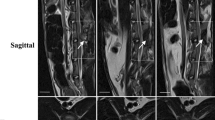Abstract
Purpose
To evaluate effectiveness of carboxymethylcellulose/polyethylene oxide (CMC/PEO) gel in improving clinical outcomes after the first-time lumbar discectomy.
Method
Ninety-three patients with herniated lumbar disc at L4–L5 or L5–S1 were enrolled and randomized into two groups: CMC/PEO gel treatment group and control group. All the patients underwent laminotomy and discectomy by posterior approach. The preoperative and postoperative Oswestry Disability Index (ODI) and Visual Analogue Scale (VAS) scores for lower-back pain and leg pain were analyzed and compared between two groups at 30- and 60-day time points.
Results
No patient presented with any clinically measurable adverse event during surgery. There were no significant differences between the treated group and the control group on the preoperative ODI and VAS scores. In general, the ODI and VAS scores decreased in both groups at all the time points. At the 30-day time point, the VAS scores for back pain and leg pain and the ODI scores in treatment group were lower by 9.9 % (P = 0.0302), 27.0 % (P = 0.0002) and 16.3 % (P = 0.0007) than those in control group. And at the 60-day time point, the ODI and VAS scores further decreased in both groups. The VAS scores for leg pain in treatment group were lower by 4.5 % than that in the control group (P = 0.0149). However, no significant difference was detected between two groups on the ODI and VAS scores for back pain.
Conclusions
The results demonstrated that CMC/PEO gel is effective in reducing posterior dural adhesions in the spine with no apparent safety issues. It can improve patients’ postoperative clinical outcome.
Similar content being viewed by others
References
Hazard RG (2006) Failed back surgery syndrome: surgical and nonsurgical approaches. Clin Orthop Relat Res 443:228–232
Weir BK, Jacobs GA (1980) Reoperation rate following lumbar discectomy: an analysis of 662 lumbar discectomies. Spine 5(4):366–370
Law JD, Lehman RA, Kirsch WM (1978) Reoperation after lumbar intervertebral disc surgery. J Neurosurg 48(2):259–263
Martin BI, Mirza SK, Comstock BA et al (2007) Are lumbar spine reoperation rates falling with greater use of fusion surgery and new surgical technology? Spine 32(19):2119–2126
North RB, Campbell JN, James CS et al (1991) Failed back surgery syndrome: 5-year follow-up in 102 patients undergoing repeated operation. Neurosurgery 28(5):685–690 (Discussion 690–691)
Zeidman SM, Long DM (1996) Failed back surgery syndrome. In: Menezes AH, Sonntag VKH (eds) Principles of spinal surgery. McGraw Hill Health Professions Division, New York, pp 657–659
Dumont RJ, Verma S, Okonkwo DO et al (2001) Acute spinal cord injury, part II: contemporary pharmacotherapy. Clin Neuropharmacol 24:265–279
Cooper RG, Mitchell WS, Illingworth KJ et al (1991) The role of epidural fibrosis and defective fibrinolysis in the persistence of postlaminectomy back pain. Spine 16:1044–1048
Geisler FH (1999) Prevention of peridural fibrosis: current methodologies. Neurol Res 21(Suppl 1):9–22
Jensen TT, Asmussen K, Berg-Hansen EM et al (1996) First time operation for lumbar disc herniation with or without free fat transplantation. Spine 9:1072–1076
da Costa RC, Pippi NL, Graça DL et al (2006) The effects of free fat graft or cellulose membrane implants on laminectomy membrane formation in dogs. Vet J 171:491–499
Pospiech J, Pajonk F, Stolke D et al (1995) Epidural scar tissue formation after spinal surgery: an experimental study. Eur Spine J 4:213–219
Kato T, Haro H, Komori H et al (2005) Evaluation of hyaluronic acid sheet for the prevention of postlaminectomy adhesions. Spine J 5:479–488
Songer MN, Rauschning W, Carson EW et al (1995) Analysis of peridural scar formation and its prevention after lumbar laminotomy and discectomy. Spine 20:571–580
Yang J, Ni B, Liu J, Zhu L, Zhou W (2011) Application of liposome-encapsulated hydroxycamptothecin in the prevention of epidural scar formation in New Zealand white rabbits. Spine J 11(3):218–223
Gazzaniga AB, James JM, Shobe JB, Oppenheim EB (1975) Prevention of peritoneal adhesions in the rat: the effects of dexamethasone, methylprednisolone, promethazine, and human fibrinolysin. Arch Surg 110:429–432
Jacobs RR, McClain O, Neff J (1980) Control of postlaminectomy scar formation: an experimental and clinical study. Spine 5:223–229
Zhang Z, Tarone G, Turner DC (1993) Expression of integrin alpha 1 beta 1 is regulated by nerve growth factor and dexamethasone in PC12 cells: functional consequences for adhesion and neurite outgrowth. J Biol Chem 268:5557–5565
Hinton JL Jr, Warejcka DJ, Mei Y et al (1995) Inhibition of epidural scar formation after lumbar laminectomy in the rat. Spine 20:564–570
Alkalay RN, Kim DH, Urry DW, Xu J et al (2003) Prevention of postlaminectomy epidural fibrosis using bioelastic materials. Spine 28:1659–1665
Gil K, Frymoyer JW (1991) The management of treatment failure after decompressive surgery. In: Frymoyer JW (ed) The adult spine: principles and practice. Lippincott-Raven Publishers, New York, pp 849–870
Fritsch EW, Heisel J, Rupp S (1996) The failed back surgery syndrome. Reasons, intraoperative findings, and long-term results: a report of 182 operative treatments. Spine 21:626–633
Rodgers KE, Schwartz HE, Roda N et al (2000) Effect of oxiplex films (PEO/CMC) on adhesion formation and reformation in rabbit models and on peritoneal infection in a rat model. Fertil Steril 73(4):831–838
Aldrete JA (1995) Epidural fibrosis after permanent catheter insertion and infusion. J Pain Symptom Manage 10(8):624–631
Kim KD, Wang JC et al (2003) Reduction of radiculopathy and pain with oxiplex/SP Gel after laminectomy, laminotomy, and discectomy: a pilot clinical study. Spine 28(10):1080–1087
Conflict of interest
Medtronic, Inc., provided the CMC/PEO gel for this study and a grant to offset study costs. Department of Orthopaedics, Xijing Hospital and Peking University Third Hospital have no financial or marketing interest in the materials or methods used, or in any of the manufacturers mentioned in this report. None of the authors own Medtronic stock.
Author information
Authors and Affiliations
Corresponding authors
Rights and permissions
About this article
Cite this article
Liu, Zc., Li, Y., Zang, Y. et al. Clinical assessment of a CMC/PEO gel to inhibit postoperative epidural adhesion formation after lumbar discectomy: a randomized, control study. Arch Orthop Trauma Surg 133, 295–301 (2013). https://doi.org/10.1007/s00402-012-1634-0
Received:
Published:
Issue Date:
DOI: https://doi.org/10.1007/s00402-012-1634-0




